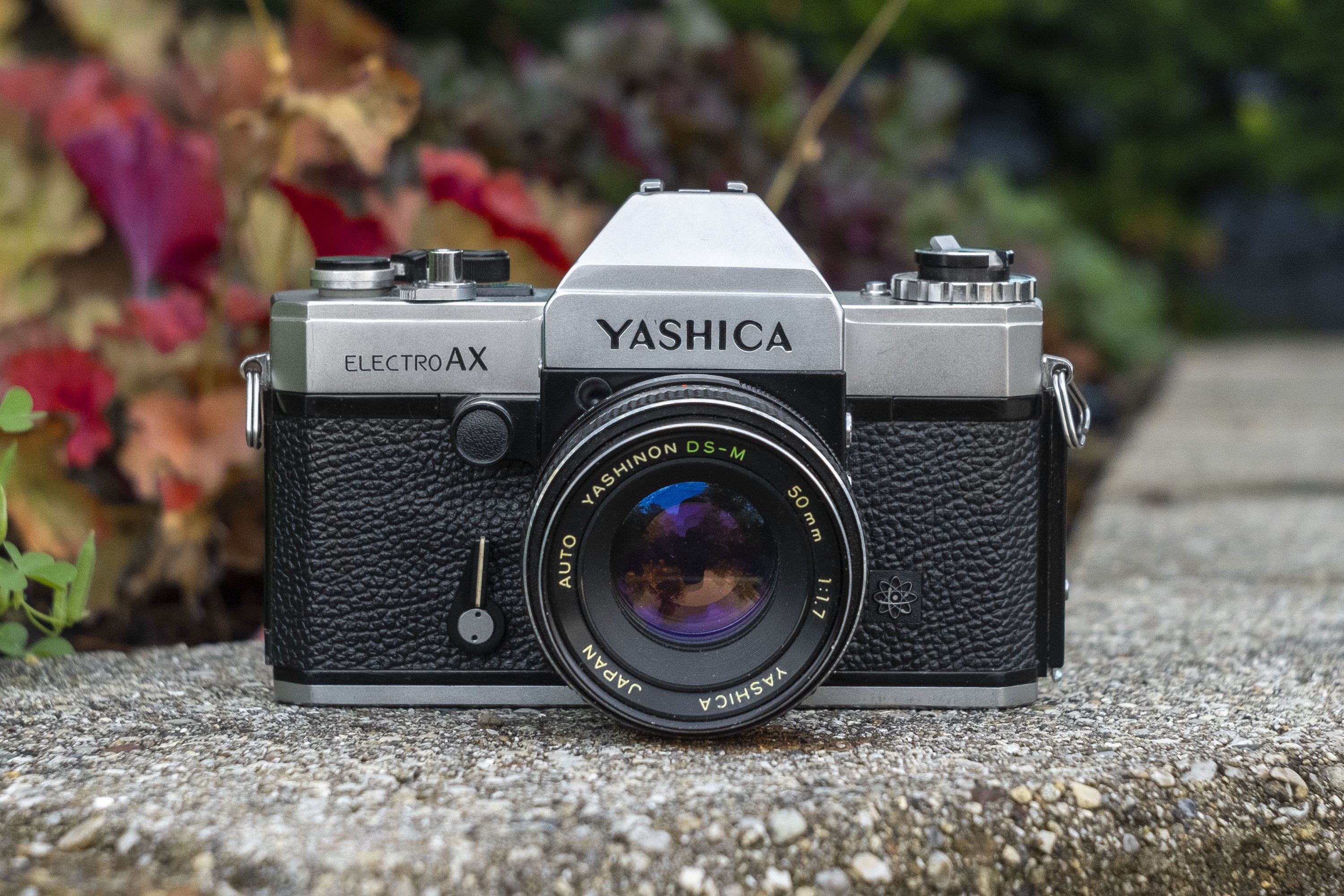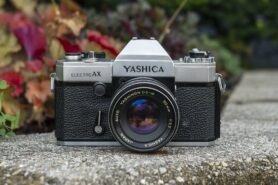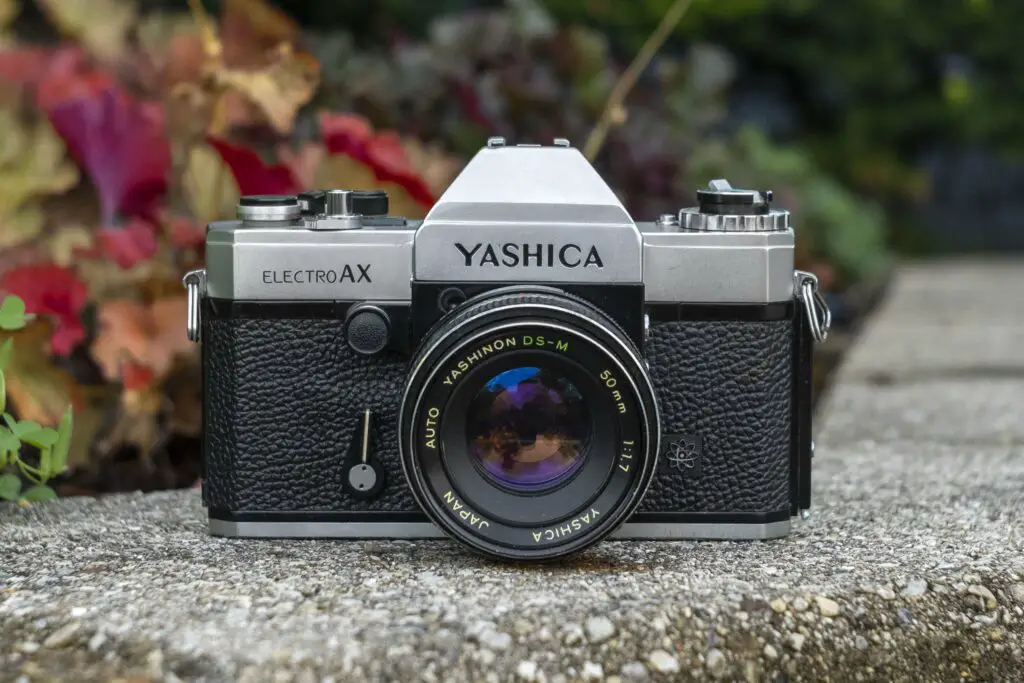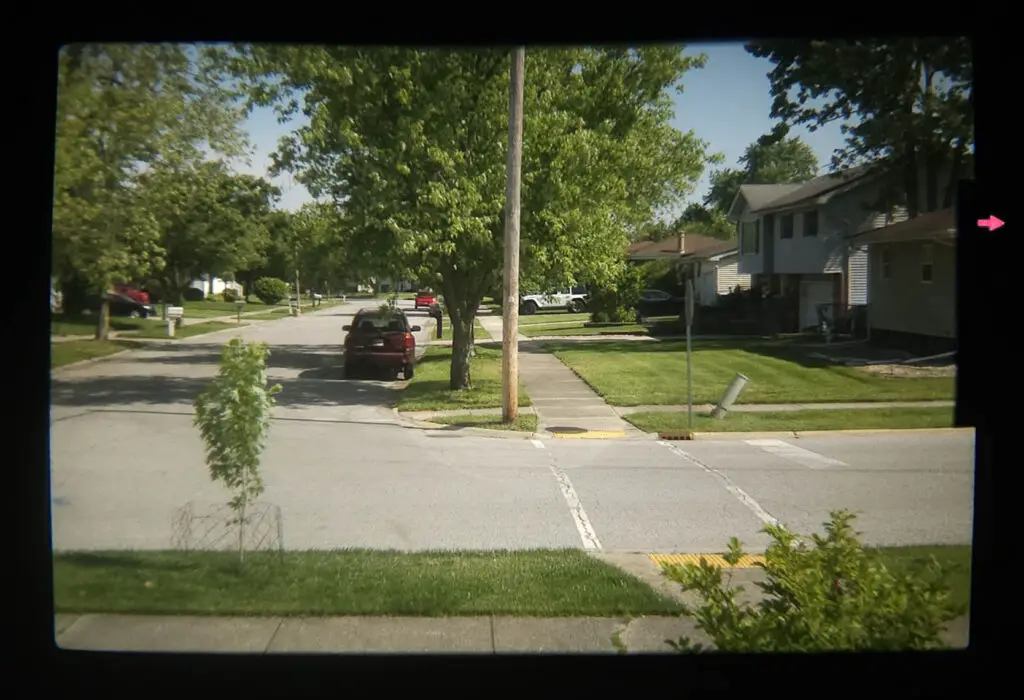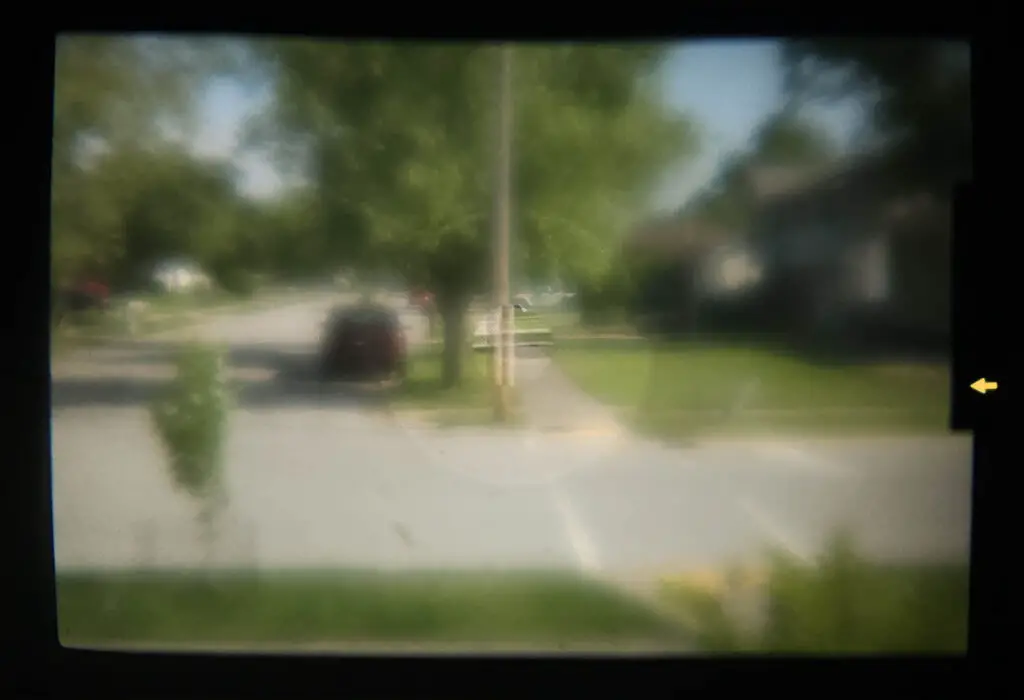This is a Yashica Electro AX, a 35mm SLR made by Yashica Co., Ltd. in Tokyo Japan starting in 1972. The Electro AX was the second to last in Yashica’s TL-series of SLRs and the only model with aperture priority auto exposure. Like other Yashica SLRs, the Electro AX uses the M42 screw mount, but the camera was designed for a new type of Yashinon DS lenses as the company’s earlier DX lenses would not work with the camera. Under normal operation, lenses are always stopped down and the AE system is on, constantly taking a reading through the lens. In order to view through the lens with the lens wide open to maximize brightness, a button on the front of the camera must be pressed to temporarily open the diaphragm and disable the AE system. The metering system on this camera was adapted from Yashica’s already successful Electro 35 series of rangefinders.
Film Type: 135 (35mm)
Lens: 50mm f/1.7 Auto Yashinon DS-M coated 6-elements in 4-groups
Lens Mount: M42 Screw Mount
Focus: 1.75 feet / 0.5 meters to Infinity
Viewfinder: Fixed SLR Pentaprism w/ Microprism Circle and Ground Glass Collar
Shutter: Copal Square Vertically Traveling Metal Blade
Speeds (Auto): 8 – 1/1000 seconds, step less
Speeds (Manual): B, 1 – 1/1000 seconds
Exposure Meter: TTL Center Spot CdS Meter w/ Viewfinder Over/Under Lamp and Aperture Priority AE
Battery: 5.6v PX32 Mercury Battery
Flash Mount: Accessory Hot Shoe and F and X Flash Sync, 1/125 X-Sync
Other Features: Self-Timer, DOF Preview, Viewfinder Blind
Weight: 940 grams, 718 grams (body only)
Manual: https://www.cameramanuals.org/yashica_pdf/yashica_electro_ax.pdf
How these ratings work |
The Yashica Electro AX is a fine camera. As one of the pioneering SLRs with Automatic Exposure, it works well, has an accurate meter, a great viewfinder, and support for excellent lenses. That it uses a screw mount requires a bit of a compromise in how the metering system works as the diaphragm needs to be stopped down before an accurate exposure reading can be made. Although this is not ideal compared to most other AE SLRs, it is still capable of excellent photography. As a user, this is a good camera, but there are many better options with the same features. | ||||||
| Images | Handling | Features | Viewfinder | Feel & Beauty | History | Age | |
| 2 | 2 | 1 | 2 | 1 | 1 | 0% | |
| Bonus | None | ||||||
| Final Score | 9.0 | ||||||
History
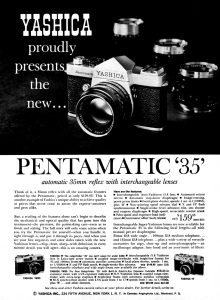
In the mid 20th century, Yashica was a brand most commonly known for a line up of “better than you’d expect” 6×6 TLRs in the style of the Rolleiflex and Rolleicord. By the end of the 1950s, with sales of medium format TLRs slowing, Yashica wanted to get into the 35mm SLR game and after an acquisition of Nicca, released the Yashica Pentamatic in 1960.
The Pentamatic was a solidly built camera with a clean and attractive design and an all new bayonet lens mount, however it had a limited number of shutter speeds and lacked modern features like an automatic film counter or the ability to work with a meter. Although two later versions of the Pentamatic would soon come out to address some of the original model’s shortcomings, it was too little too late, and by 1962, Yashica had already pivoted to models using the M42 “universal” mount. In hindsight, the Pentamatic wasn’t a bad camera, it just couldn’t compete with models coming out at the same time by other Japanese companies. In an article I wrote where I ranked every Japanese camera maker’s first 35mm SLR, the Yashica Pentamatic only managed 12th place out of 14.
Not all was bad though, as once Yashica pivoted towards simpler, and less expensive cameras using a lens mount that was compatible with a huge number of Japanese and German designs, sales began to climb. First was the Yashica J-series which consisted of several models from the simple, unmetered Petna J, to the CdS body metered J-3, to the “sorta” top of the line J-7.
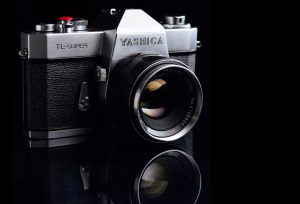
In 1966, Yashica modernized the J-series, adding in body TTL metering. Dropping the J-prefix, the new model called the Yashica TL Super was a good seller that had enough features that it appealed to advanced amateurs, but was cheap enough to also appeal to beginning photographers. Seemingly hitting their stride in making 35mm SLRs, in 1968 the TL series was upgraded with electronic shutters and exposure lamps instead of analog needles. The new Yashica TL Electro were some of the most advanced screw mount SLRs in the world.
Now with a full range of shutters speeds, in body TTL metering, a lamp based metering system and an electronically timed shutter, Yashica set their sites on a feature which was already quite popular among non SLR cameras, automatic exposure. Although AE had been a popular feature since the late 1950s on simple point and shoot and box cameras, nearly all early AE systems were quite simple and didn’t support a wide range of shutter speeds and apertures. They also required lenses to be permanently fixed to the camera.
The challenge with developing AE on an interchangeable lens camera is that the metering system, which is almost always located in the body, needs to be able to directly communicate with the lens to know what f/stop it is set at. The late 1960s and early 70 was still before the dawn of computerized cameras in which electrical communication between body and lens was possible. In the early 1970s nearly every camera was maker was working towards solving this problem. Some had it easier than others though. Brands like Nikon and Canon which already had bayonet lens mounts found that by adding a mechanical linkage, the position of the aperture ring could communicate back to the body, telling the AE system how much light will come through the lens.
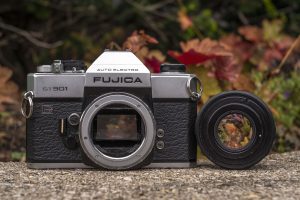
With a screw mount like Yashica used, the precise location of these linkages wasn’t always exact. Between various makers of screw lenses and screw mounts, there is a certain amount of wiggle room in which the lenses can be mounted in slightly different orientations, which if you need a mechanical linkage to determine the position of the aperture ring, would be a problem. Some manufacturers like Fuji and Ricoh solved this by modifying the mount, adding notches, or posts that would positively locate the lens. Yashica would eventually settle on a method in which the lens didn’t actually communicate anything, but rather the body would always stop down the lens and then take a meter reading with the diaphragm in the shooting size before calculating shutter speeds. This system worked, but it was slower, and had the negative effect of darkening the viewfinder.
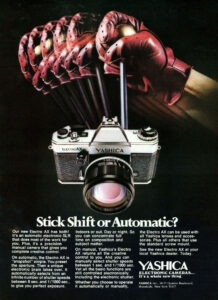
In 1972, six years after the release of the Yashica TL Super, came the Yashica Electro AX. Using a modified version of the Electro metering system on its earlier SLRs and some rangefinder cameras, the Electro AX offered aperture priority automatic exposure with most, but not all M42 lenses. In their advertisements for the Electro AX, Yashica suggested their new camera was like an automobile with both a stick shift and automatic transmission. Use the AE mode for when you need it, and set a manual speed when you don’t.
When it was released, the Yashica Electro AX carried a manufacturer’s suggested retail price of $510, which was up from the earlier Yashica TL-Electro X at $380, but less than the AE equipped Fujica ST-901 at $595. When adjusted for inflation, the Electro AX had a retail price of just over $3300 today, quite a high price to pay for a cutting edge feature on a camera made by a company not known for cutting edge technology.
In my research for this article, I could find no contemporary reviews of the camera, so it is difficult to tell how well the model was received by the public, or how well it sold. Although Yashica had a generally positive reputation among the economy crows, to consider an inflation adjusted price of over $3000 was likely a tough sell.
The following dealer guide for the Yashica Electro AX comes from the Pacific Rim Reference Library.
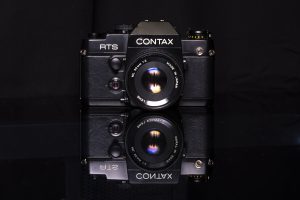
It is not clear how long the Yashica Electro AX was produced, but it still showed up in advertising in late 1974, so it likely remained in production along with the earlier Yashica TL-Electro X ITS model until 1975 when Yashica formed a partnership with Zeiss to release a new type of premium Yashica/Contax SLRs with an all new bayonet lens mount, support for higher end Zeiss lenses, and more modern features. Yashica’s partnership with Zeiss would continue through their October 1983 acquisition by the Japanese ceramics company, Kyocera, and the two would continue producing cameras in the Contax line until until the early 2000s.
Today, most Yashica SLRs fall into the category of “good, but unremarkable”. I guess this is a fair assessment as none of Yashica’s homegrown SLRs ever pioneered a new technology and mostly just followed what others were doing. These were fine cameras with fine lenses, fine build quality, and sold at prices that most people wouldn’t find objectionable, but they were never exciting. That lack of excitement continues through today as most collectors see these cameras as “fine” examples of 1960s and 70s Japanese SLRs. The good news is, that these cameras usually hold up well and can often be found at discount prices. If you’re looking for a first SLR for someone looking to try shooting 35mm film, you could do a lot worse than an SLR like the Yashica Electro AX.
My Thoughts
One of the earliest reviews on this site was for the Yashica Electro 35 GS. The Yashica Electro 35 was a rangefinder camera which first debut in 1966 and remained in production until the mid 1970s. It was a solid rangefinder camera with an excellent, but fixed f/1.7 Yashinon lens and Yashica’s “Electro” aperture priority auto exposure system. Unlike most other metered cameras of the era, the Electro used small lights in the viewfinder and on the top plate to indicate when exposure was above or below what the AE system could handle. Yashica pioneered the use of lights over needles and it proved to be successful as the Electro 35 rangefinder sold really well.
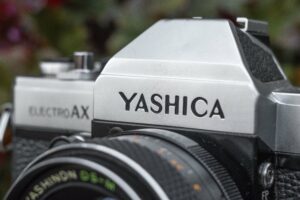
With the rangefinder model selling well, it probably wasn’t a surprise that at one point, Yashica had the idea of incorporating the same system into an interchangeable lens SLR. Shortly after the original Electro rangefinder was made, in 1968 Yashica released an SLR with the Electro name called the Yashica TL Electro X. Shortly after that came the Yashica Electro AX, a cleanly styled SLR in the style of the other SLRs the company made at the same time. The Yashica Electro AX is a bit heavier than other Yashica SLRs, likely due to the increased complexity of the camera and the build quality was about as good as anything coming out of Japan at the time. It shared the same M42 lens mount and support for Yashinon lenses primarily built by Tomioka, which were excellent performers, making images that were as good as anything on the market.
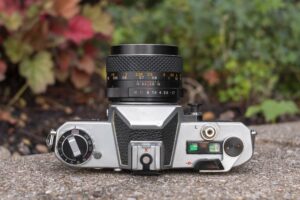
Up top, the Electro AX has a simpler control layout than you’d expect from other SLRs. On the left is the combined rewind knob with fold out handle and shutter speed selector below. The shutter speed selector has manual positions for speeds from 1 to 1/1000 plus Bulb and an additional position marked in red for Auto. The Auto position can be selected directly from the B or 1000 position. When in Auto mode, the shutter speed selector is locked in position to avoid accidentally taking the camera out of AE mode. To purposefully take it out of Auto mode, a small chrome button below and to the right must be pressed to unlock it.
Above the fixed pentaprism is the flash hot shoe with a red X which matches a red X on the shutter speed dial at the 1/125 position. The Yashica Electro AX uses a version of the Copal Square vertically traveling shutter, which was an upgrade from the cloth shutter of some earlier Yashica SLRs.
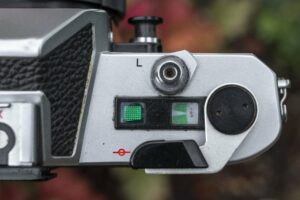
To the right of the prism is a green lamp which is only used at shutter speeds of 1/30 and below, in which this light will remain on throughout the duration of the exposure. The idea of this lamp was to remind people not to move the camera until after the exposure is finished. At speeds above 1/30 the green light will blink, but isn’t needed for anything. To the right of the green lamp is the automatic resetting exposure counter, which has its own built in light which functions as the battery check light. Pressing a black button on the rear of the camera will light up the exposure counter, which indicates the battery has a sufficient charge. Above the exposure counter is the cable threaded shutter release with a shutter release lock collar below it. With the collar in the L position, you cannot fire the shutter. Finally, to the right is the film advance lever which has a relatively short throw to fully advance the film and cock the shutter.
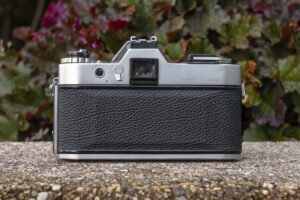
Around back, we see the black battery check button I mentioned earlier, then a viewfinder black out switch. As the metering circuit for the Yashica Electro AX are inside the viewfinder, it is possible for ambient light to enter the rear viewfinder during long exposures, possibly throwing off the metering circuit, so you would use this switch to close the viewfinder during long exposures to ensure an accurate measurement of light. The rectangular eyepiece for the viewfinder has notches on the side for a selection of eyepiece accessories. Finally, to the right is the camera’s serial number and the word “Japan”.
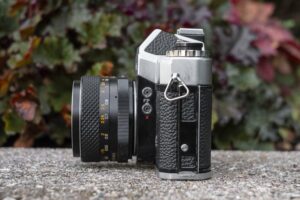
Both sides of the camera have metal strap lugs and on the left side is the film door release lock. The lock has both a sliding lever on the bottom but also a chrome button that must be pressed before you can release the door lock. This is there to ensure that the film compartment can’t accidentally be opened while film is in the camera.
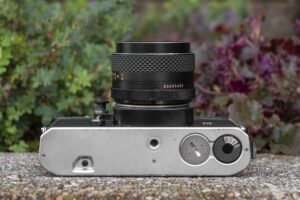
On the bottom of the camera is a black plastic film rewind button, centrally located 1/4″ tripod socket, a round door for the PX32 Mercury Battery, and an ASA film speed dial with settings from ASA 25 to 1600.
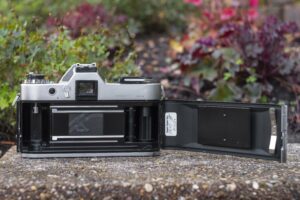
The film compartment is rather standard for a 1970s SLR. Film transports from left to right onto a fixed, and multi-slotted plastic take up spool. Although the Electro AX predates any type of automatic film load system, the design of the take up spool makes attaching the leader very simple. The film gate reveals the intricate arms and blades of the Copal Square shutter. Above and below the film gate are two polished metal film rails. Inside the film door is a large, metal film pressure plate covered in divots which reduce friction as film passes over it, and a small clip on one side to maintain pressure on the 35mm cassette. The door hinge has a velvet light seal, but both door channels have a foam seal which by now will have rotted away on all examples of this camera, requiring replacement before you can use the camera.

Although the Yashica Electro AX supports the M42 universal mount and can be used with a huge number of lenses, the kit lens that most came with was the Yashinon DS-M 50mm f/1.7 lens. Looking down upon the lens, we see the aperture ring closest to the body. It has click stops indicated from f/1.7 to f/16 with a dot at the f/2 stop. In front of the aperture ring is an engraved depth of field scale with a red index mark for IR, and in front of that is the focus ring. The focus ring is marked in both feet and meters from 1.75 feet/0.5 meters to infinity. The focus ring has a rubber grip around its circumference and is very smooth and easy to rotate.
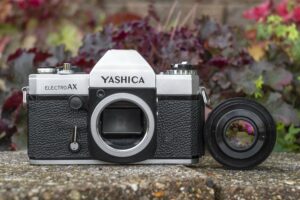
Up front, the Yashica Electro AX has a normal M42 screw mount. There are no additional linkages, divots, or notches like some other screw mount AE cameras. For someone unfamiliar with this model, there is nothing on the front to suggest this camera supports automatic exposure. A standard looking mechanical self timer lever is below and to the right of the lens mount, and there are two flash sync ports on the right side of the mirror box. The only thing that stands out is a round black button to the left and above the lens mount. Strangely, due to a change in the shape of the Electro AX’s mirror, the manual warns that several Yashinon-DX lenses are incompatible with the camera. They range from a 21mm wide angle, through most 50mm lenses.
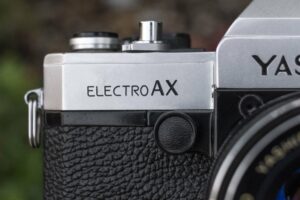
The Electro AX’s user manual calls this black button the “Aperture Activator Button” which I think is misleading. If anything, it does the opposite of what its name suggests. This button is like a reverse depth of field preview button because with the shutter cocked, without touching the button, the diaphragm always closes to the chosen f/stop on the lens. If you have the lens set to f/11 with the shutter cocked, the aperture will physically be at f/11 and the viewfinder will be dark, as if you had been pressing a DOF preview button on any other camera. With the diaphragm stopped down, the TTL CdS meter can take an accurate measurement of light passing through the lens and calculate and appropriate shutter speed for proper exposure.
If, however, you want to compose your image with the diaphragm wide open to increase the amount of light entering the viewfinder, you must press and hold this button. Doing this opens the diaphragm as far as it will go, overriding the metering system. With the camera in AE mode, when pressing this button to open the diaphragm to maximize the amount of light entering the viewfinder, you must remember to release button, so the lens can stop back down and an accurate meter reading can be taken. When shooting the camera in manual mode, it doesn’t matter what you do as you control the exposure. I realize that as I type this, it sounds overly confusing, but in practice its not. Just remember, button pressed, aperture open, button not pressed and shutter cocked, lens stopped down.
The viewfinder of the Yashica Electro AX is sufficiently good, but about on par for what other companies were making in 1972 when this camera was released. The focusing screen has a fine matte Fresnel pattern which evenly spreads the image from corner to corner without any significant darkness in the corners. It is not as bright as later SLRs from the 80s and 90s, but is bright enough for most shooting situations. In the center is a microprism circle, surrounded by a ground glass collar which approximates a majority of where the exposure system will measure. No split image focus aide was offered in the Yashica Electro AX and the screens are not interchangeable.
On the right side is a darkened rectangle which contains two arrows, both illuminated by lamps when the camera is in Auto mode and the shutter release is pressed half way down. The metering system is disabled with the shutter selector on any manual speed. The arrows will only light up with the shutter release in a very specific position, if you press it too far, the arrows will go off again. A red right arrow on top indicates over exposure telling you that with the chosen f/stop, the camera cannot choose a shutter speed that will result in proper exposure. You either need to choose a smaller aperture, use a neutral density filter on your lens, or recompose your image so that there is less light.
If you see a yellow left arrow near the bottom of the rectangle, this means that a shutter speed below 1/30 second is needed for proper exposure. Unlike the red arrow, the yellow arrow does not mean that the camera can’t expose it, but that you need to stabilize the camera to prevent motion blur. The Yashica Electro AX is capable of automatic exposure down to 8 seconds, so the yellow is merely a warning. There is no lamp that indicates proper exposure with a fast shutter speed. When neither the red or yellow arrows light up, pressing the shutter release the rest of the way will result in both a shutter speed above 1/30 and a proper exposure. If this red and yellow arrow feature sounds familiar, it is the exact same system used on other Yashica Electro rangefinders and SLRs.
There is a lot to like about the Yashica Electro AX. It manages a good AE system proven from Yashica’s earlier cameras, into an interchangeable lens SLR. A few compromises must be made to get around certain limitations, but they’re not too bad. Like other Yashica SLRs, the Electro AX is a well built camera, with an accurate metering system, and support for excellent lenses. But what is it like to shoot? Keep reading!
My Results
Feeling reasonably certain the Yashica Electro AX was in good working condition and also that I’ve received good quality results from Yashica cameras before, for my first roll, I loaded in a bulk roll of some Kodak Panatomic-X that had expired in 1968. While I am no stranger to shooting expired Pan-X, this was the oldest film I’ve ever tried to shoot. Would it hold up as well as the less expired rolls I’ve shot, or would the camera fail me and produce an entire roll of nothingness?
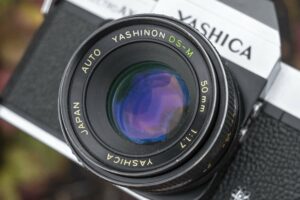
As always, my images from the expired Kodak Panatomic-X turned out great, even this 1968 expired bulk film. To think that something that expired 10 years before I was born, still shoots well today, without any noticeable degradation, at box speed is truly mind blowing!
As for the camera itself, the Yashica Electro AX is as good as any other Yashica Electro SLR or rangefinder. I usually like to avoid SLR to rangefinder comparisons, but in this case, I think it holds up well as the metering system is the same, the usability is similar, and the optics are very similar too. This is literally just an SLR version of the Electro 35 rangefinder.
The images I got were sharp corner to corner, making good use of the very tiny grain and sharp details offered by the slow ASA 25 Pan-X film. I noticed no obvious softness or vignetting near the corners, and although I did not shoot any color film through the Electro AX, I have shot enough of it on other Yashinon equipped cameras to know that the images would have looked stellar. As an aside, for those of you who shoot or collect Contax SLRs, there is this believe that the Zeiss branded lenses are better than the Yashinon lenses for those cameras, but I disagree. For the money, the Yashinons are just as good.

Beyond the optics, the shooting experience with the Electro AX was good, and without any major cons. On the plus side, the metering system worked great. I kept the camera in Auto mode for the entire roll and the entire roll was perfectly exposed, even interior shots. I had no issue getting accurate focus even though the focus screen isn’t as bright as on some later SLRs, and the ergonomics were excellent compared to other 1970s SLRs.
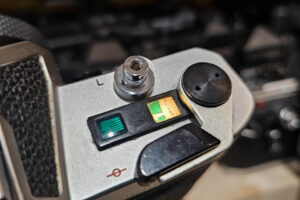
Where things got a little disappointing was that with the microprism circle, and still visible Fresnel pattern, I felt like I was using a camera from a decade before. That I had to press and hold a button when the shutter was cocked to see a bright viewfinder was odd. It wasn’t difficult to do, and I did get used to it, but it is still strange. Adding to the curiosity of this decision is that several other Japanese camera makers would release M42 mount SLRs with automatic exposure without needing to do it. Yes, it works, but you’ll never shake the need of asking yourself, “why”? Had I bought this camera brand new in 1972 and saw how quickly other manufacturers found a better way to implement AE, I probably would have had some pretty significant buyer’s remorse.
One good thing about reviewing old cameras however, is that models with quirky features can actually be fun. That the Yashica Electro AX ISN’T like any other 1970s SLR works in its favor. In a weird sorta way, I had fun pressing the black button, making the viewfinder go from dark to bright and back to dark again. For as much of a fuss I made about it, it really didn’t slow me down much, and certainly had no impact on the quality of images I got from it.
That this camera was rather unloved when it was new, means it likely flies under the radar of most collectors and shooters, when in reality, it is quite a nice and capable camera, with great lenses. If you’re new to film photography and want to try a 35mm SLR, you could do a lot worse than this camera. With the benefit of AE and support for most M42 lenses, the Yashica Electro AX is an excellent camera to bridge old with new. If you have some old Takumars or West German Zeiss lenses, as long as they support the automatic diaphragm feature, and don’t make contact with the reflex mirror, you can see what they look like with the benefit of a very good auto exposure system. The Yashica Electro AX isn’t perfect, but it doesn’t have to be. At the prices these things usually sell for, I have no problem recommending it to someone looking for something just a little different.
Related Posts You Might Enjoy
External Links
http://camera-wiki.org/wiki/Yashica_TL_Electro_AX
https://yashicasailorboy.com/2020/01/31/yashica-electro-ax-yashicas-goofy-automatic-exposure-slr/
https://www.photo.net/forums/topic/518054-the-quirky-yashica-electro-ax/

